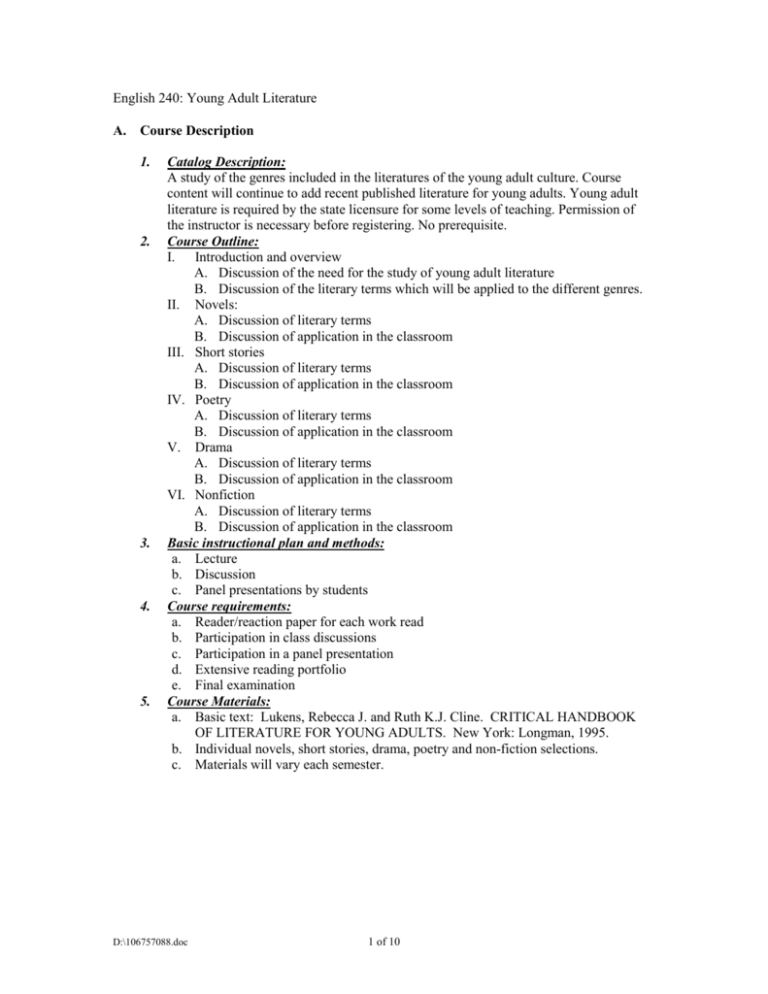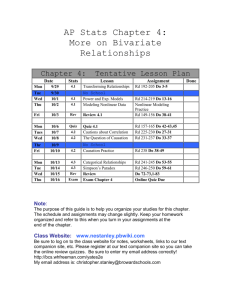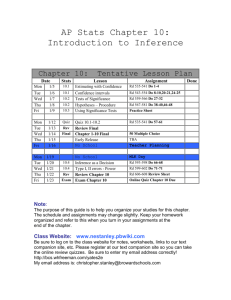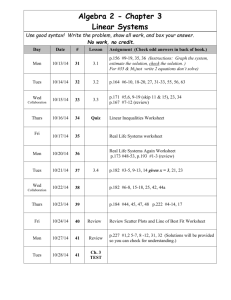English 240: Young Adult Literature
advertisement

English 240: Young Adult Literature A. Course Description 1. 2. 3. 4. 5. Catalog Description: A study of the genres included in the literatures of the young adult culture. Course content will continue to add recent published literature for young adults. Young adult literature is required by the state licensure for some levels of teaching. Permission of the instructor is necessary before registering. No prerequisite. Course Outline: I. Introduction and overview A. Discussion of the need for the study of young adult literature B. Discussion of the literary terms which will be applied to the different genres. II. Novels: A. Discussion of literary terms B. Discussion of application in the classroom III. Short stories A. Discussion of literary terms B. Discussion of application in the classroom IV. Poetry A. Discussion of literary terms B. Discussion of application in the classroom V. Drama A. Discussion of literary terms B. Discussion of application in the classroom VI. Nonfiction A. Discussion of literary terms B. Discussion of application in the classroom Basic instructional plan and methods: a. Lecture b. Discussion c. Panel presentations by students Course requirements: a. Reader/reaction paper for each work read b. Participation in class discussions c. Participation in a panel presentation d. Extensive reading portfolio e. Final examination Course Materials: a. Basic text: Lukens, Rebecca J. and Ruth K.J. Cline. CRITICAL HANDBOOK OF LITERATURE FOR YOUNG ADULTS. New York: Longman, 1995. b. Individual novels, short stories, drama, poetry and non-fiction selections. c. Materials will vary each semester. D:\106757088.doc 1 of 10 6. References The following is provided as a beginning research list for those wishing to locate references for the study of young adult literature. Annotation is provided for sources. Bodart, Joni Richards. World-Class 100 Thin Books or What to Read When Your Book Report is Due Tomorrow. Englewood, Colorado: Libraries Unlimited, Inc., 1993. Discusses books with regard to subject areas, characters, plot summaries, and main themes. Offers book talks and book report ideas. Bushman, John H., and Kay Parks Hass. Using Young Adult Literature in the English Classroom, 3rd edition. Upper Saddle River, NJ: Prentice-Hall, 2001. Defines young adults and young adult literature; discusses how to evaluate the literature and use in classes, examines censorship issues and provides booklists. Darby, Mary Ann and Miki Pryne. Hearing All Voices. Lanham, Maryland: Scarecrow Press, 2002. Provides annotated bibliography for 6-9th grades—multicultural literature is stressed. Eiss, Harry. Literature for Young People on War and Peace: an Annotated Bibliography. New York: Greenwood Press, 1989. Excellent source of a listing of various selections concerning the wars. Wonderful discussion of the books in relation to the various wars and the coping of the young adults to the situation. Estes, Sally.ed. Genre Favorites for Young Adults. Chicago: Booklist Publications, 1993. Annotated listed of popular works since 1980 for young adults. Includes many works not on a list for young adults previously. Herald, Diana Tixier. Teen Genre Reflecting. Englewood, Colorado: Libraries Unlimited, 1997. Wonderful source for providing an annotated bibliography for different genres for young adults. Herz, Sarah K., and Donald R. Gallo. From Hinton to Hamlet. Westport, Connecticut: Greenwood Press, 1996. Defines young adult literature, discusses value of young adult literature and its connection to other widely recognized literature in various disciplines, includes additional resources. Hunt, Gladys and Barbara Hampton. Read for Your Life: Turning Teens into Readers. Grand Rapids: Harper Collins, 1992. Provides a list of many young adult works and many adult novels included to tie the ages together. Kaywell, Joan F.,ed. Adolescent Literature: As a Complement to the Classics. Vol.1. Norwood, MA: Christopher-Gordon Publishers, Inc., 1993. Examines young adult literature according to themes and relates them to classic or near classic literature. Kaywell, Joan F., ed. Adolescent Literature: As a Complement to the Classics. Vol. 2. Norwood, MA: Christopher-Gordon Publishers, Inc., 1995. Discusses young adult literature as it relates to identity issues, multicultural features and individuals’ responsibility to society. Kaywell, Joan F., ed. Adolescent Literature: As a Complement to the Classics. Vol. 3. Norwood, MA: Christopher-Gordon Publishers, Inc., 1997. Stresses censorship, directly ties young adult literature with the classics and provides activities to be used with the works. Kaywell, Joan F., ed. Adolescent Literature: As a Complement to the Classics. Vol. 4. Norwood, MA: Christopher-Gordon Publishers, Inc., 2000. Stresses multicultural topics and works. Readers are encouraged to form discussion groups before reading, during and after reading the literature of choice. D:\106757088.doc 2 of 10 Lukens, Rebecca J. and Ruth K. J. Cline. Critical Handbook of Literature for Young Adults. New York: Longman, 1995. Is a very useful text for a class for prospective teachers of middle and high school students. Discusses the elements of literature and relates them to various selections of young adult literature. Monseau, Virginia.ed., The Lure of Young Adult Literature. Spec. issue of English Journal. 90.3 (January 2001): 1-155. Entire journal refers to young adult literature. Mentions different cultures, different interest levels, contemporary works both fiction and non-fiction. Monseau, Virginia ed., Responding to Young Adult Literature. Portsmouth, NH: Heinemann, 1996. Introduction by Chris Crutcher stresses the psychological-sociological value of young adult literature. Makes literature important to the lives of young people. Moore, John Noell. Interpreting Young Adult Literature: Literary Theory in the Secondary Classroom. Portsmouth, NH: Heineman, 1997. Looks at young adult literature in terms of “young adult,“ “literary theory,” and “social constructivism.” Nilsen, Alleen Pace and Kenneth L. Donelson. Literature for Today’s Young Adults. New York: Longman, 2001. A wonderful textbook for an English teaching methods class or a reference for the classroom teacher. Offers listings and discussions of many works within specific genres. Reed, Arthea J. S. Comics to Classics. Newark, Delaware: International Reading Association. 1988. A discussion and listing of books for teens and preteens. The source discusses the relationship between books and the comics, stressing the positive use of comics in the young person’s reading. Reid, Louann ed. Rationales for Teaching Young Adult Literature. Portland, Maine: Calendar Islands Publishers, 1999. Discusses the” hows” and “whys” of our teaching certain young adult works. Stresses the importance of teaching young adults that is value in the literature of their age group and the way this literature relates to their lives. Wood, Ruth.ed. Wisconsin English Journal. 142, 2. Eau Claire, WI: Wisconsin Council Teachers of English Language Arts, Fall 2001. Entire journal refers to teachers’ experiences with teaching young adult literature. The following is a list of World Wide Web Sites which should prove valuable for further references. These sites are listed in Literature for Today’s Young Adults (listed in above bibliography). The ALAN Homepage: Assembly on Literature for Adolescents from National Council of Teachers of English.This site offers links to related young adult literature and the ALAN Review. http://english.byu.edu/alan/ Booktalks: D:\106757088.doc 3 of 10 Offers a guide to many booktalks for the young adults. Very easy to locate by author, subject, title and topic. Additional information is offered on a number of the works. http://rms.concord.k12.nh.us/booktalks/ Electronic Resources for Youth Service: Lists award winning books, book reviews, various links to other listservs, and resources for teachers and librarians interested in young adult literature. http://www.chebucto.ns.ca/Education/ERYS/ The Young Adult Library Services Association (YALSA) Home Page: Offers a wide variety of information, including award winning books, information for teachers and librarians and links to other related sites. http://ala8.ala.org/yalsa/ Young Adult Literature: Middle and Secondary English-Language Arts Offers a very broad range of cultures, topics, authors’ homepages, and gender-based literature for the young adult. http://falcon.jmu.edu/-ramseyil/yalit.htm B. Rationale 1. 2. Statement of major focus and objectives: Students who take this course will study young adult literature, including novels, poetry, drama, short stories, non-fiction. The class will provide insight in how to implement these works of literature into the classroom setting. Students will demonstrate knowledge of a substantial number of works of young adult literature. Students will demonstrate the understanding of the implementation of the works in the middle and high school classrooms. Students will be able to demonstrate the use of transfer of learning from young adult literature to the various disciplines. New course contributes to departmental curriculum: As class requirements and activities are discussed and listed on the syllabus, objectives will be identified by the letters listed below. a. It will promote students’ abilities to identify and understand specific elements and assumptions of the particular discipline. In this course students will learn to identify the relevant literary elements of young adult literature. The instructor will emphasize the terminology essential to the specific genre. The students should gain an awareness of how to analyze young adult literature. b. It will promote students’ abilities to understand how historical context, cultural values, and gender influence perceptions and interpretations. D:\106757088.doc 4 of 10 3. Students will be exposed to young adult literature which represents different historical, cultural values, and genders. Students will consider these areas when deciding on what young adult literature should be taught. Students will analyze a variety of literary works. c. It will promote students’ abilities to understand the role of critical analysis in interpreting and evaluating expressions of human experience. Students will need to use analytical skills when interpreting and evaluating texts in connection with censorship, community acceptance, students’ gender, culture, and text readability. No course will be dropped if this course is approved. C. Impact of this course on other Departments, Programs, Majors or Minors: 1. No, it does not affect the number of required credits. 2. Education Department Attached: Financial and Staffing Data Sheet, Approval Form D:\106757088.doc 5 of 10 English 240 :Syllabus Fall 2003 English 240 Introduction to Literature Young Adult Literature Minne 347A MWF 2:00-2:50 Associate Professor Goldie Johnson Minne 330 507-457-5856 (long distance calls can not be returned) e-mail: gjohnson@winona.edu Office Hours: Monday 10-11:00, Tuesday 10-12:30, Wednesday 10-11:00, 12-1:00, Thursday 10-12:30, Friday 10-11:00, 12-1:00. Counts for University Studies—Humanities This course is designed as an introduction to young adult literature. The course is designed primarily for the middle school and high school teachers of literature. Although the course can be taken for general education credit, the focus will be on the ways to implement the writings into the curriculum. It is a required course for many levels of teaching in the new licensure program. The readings will be extensive in order for the college student to “catch-up” with the young adult world. Although time may not permit covering the assigned readings as thoroughly as one would like, all assigned readings are to be completed by the student. All papers are to follow the format presented in class and follow all good writing skills. Any research and documentation are to follow the MLA format. Assignments listed on the syllabus are due on the date listed. Please check ahead for some assignments do take more time. Quizzes may be given on the material. Quizzes may not be made up. However, you may drop the lowest. All assignments are due at the beginning of the class period. NO LATE PAPERS WILL BE ACCEPTED. Discussions will be in a logical orderly manner. Since class discussion is an important part of learning you are expected to attend class. Absence of two or more classes will result in a lower grade. If it is absolutely necessary to be absent you will need to get the notes from a class member. If after getting the notes you have questions relating to the missed material, see me. Plagiarism is the failure to document whenever you have used any material which is not your own idea or common knowledge. Plagiarism will result in failure for the course. If plagiarism is suspected the student will need to furnish sources and working materials to prove the paper is the work of the student. Grading will be as follows: Attendance, class discussion, quizzes and participation in activities: 20% Reading file: 30% Reading reaction/review papers: 20% (placed in final reading file as well) Group presentation: 20% Final exam: 10% Textbooks: Lukens, Rebecca J. and Ruth K. J. Cline. CRITICAL HANDBOOK OF LITERATURE FOR YOUNG ADULTS. New York: Longman, 1995. Novel list was given to you at time of registration. If you do not have a copy see me. Short story and poetry lists are given at this time. D:\106757088.doc 6 of 10 English 240: Young Adult Literature Section 4 Fall Semester 2003 Associate Professor G. Johnson Minne 347A Sept. 3 Wed. Discussion of course requirements and expectations. (a, b, c) Sept. 5 Fri. Discussion of the definition of Young Adult Literature. Discussion of Appendix B “Understanding Adolescents and Their Reading” 181-186, Preface vii-xii, Chapter 1 “Literature and the Young Adult Reader” 1-5 all in CRITICAL HANDBOOK OF LITERATURE FOR YOUNG ADULTS. This text will be referred to as CRITICAL for the rest of the semester. (a, b) Sept. 8 Mon. Continue discussion. Directions given for the paper which is due on Sept. 10. Discussion of censorship. (c) Sept. 10. Wed. Discuss CHOCOLATE WAR. Reaction/review of the novel due. This first reader/reaction paper should be the overall reaction to the entire novel. (a, c) Sept. 12 Fri. Discuss Chapter 1(Character) 7-27 in CRITICAL. Sept. 15 Mon. Continue discussion relating element of character to The Cay and Jemmy. Reaction/review paper due for EACH of the novels. (2 papers) Sept. 17 Wed. Continue discussion of novels—concentration is on character. (a) Sept. 19 Fri. . Discussion of plot 31-54 in CRITICAL. Sept. 22 Mon. Continue discussion. . Sept. 24 Wed. Discuss novels, Holes and The Outsiders. Reaction/review paper due for each of the two novels. Concentration in discussion is on plot. Sept. 26 Fri. Continue discussion Sept. 29 Mon. Discussion of theme 59-80 in CRITICAL. (a) Oct. 1 Wed. Reaction/review paper due for Great Expectations and The Pigman Discussion of the novels concentrating on theme. Oct. 3 Fri. Continue discussion Oct. 6 Mon. Discuss setting 85-98 in CRITICAL. (a) Oct. 8 Wed. Reaction/review paper due for The Giver and To Kill A Mockingbird. Concentration of discussion is setting. (a, b) Oct. 10 Fri. No class. D:\106757088.doc 7 of 10 Oct. 13 Mon. Discussion of point of view 101-112 in CRITICAL.(a) Oct. 15 Wed. Reaction/review paper due for House on Mango Street and The Hobbit. Discussion concentrates on point of view.(a, b) Oct. 17 Fri. Continue discussion. Oct. 20 Mon. Discussion of tone 137-139. Reaction/review of Adventures of Tom Sawyer and The Westing Game. (c) Oct. 22 Wed. Discussion of the novels. Oct. 24 Fri. Finish discussion Oct. 27 Mon. Reaction/review paper due for Inherit the Wind. Discussion of the drama. (a, b) Oct. 29 Wed. Continue discussion Oct. 31 Fri. Discussion of poetry in Critical 151-168. Reaction/review paper due on 3 selections from Witness. Discussion of Witness by Hesse. Discuss the work as a collection of poetry. (b) Nov. 3 Mon. Continue discussion. Nov. 5 Wed., Nov. 7 Fri. Nov,10 Mon. (no class), Nov. 12 Wed., Nov. 14 Fri. Discussion of the poetry. Check the separate sheet to find a listing. You will need to find these very common works. Copies will not be distributed in class. You will need to have a copy for your reading file. Nov. 17 Mon. Time will be given for the groups to begin work on the short story presentations. A list of short stories will be given as a guideline to use. FINAL READING FILES DUE. Nov. 19 Wed. Groups work on presentations. Nov. 21 Fri. Groups will provide an outline and bibliography for the presentation. Nov. 24 Mon. Groups will work in class on presentations. Dec.1 Mon., Dec. 3. Wed., Dec. 5 Fri., Dec. 8 Mon., Dec.10 Wed, Dec. 12 Fri. final presentations with the short stories. (a, b, c) Final examination: Dec. 17 at 10:30-12:30 Reaction/Review Papers for Young Adult Literature Directions for the reaction/review papers. Note the due dates from the syllabus. The actual paper for each work must follow the MLA format for the writing of research papers. These must be double-spaced. Point is quality not quantity. The length should not exceed 3 pages for each selection. With the novels you will need to provide an additional page (approximate) of the D:\106757088.doc 8 of 10 compare/contrast mode. The reaction is the overall sense of the probability of teaching the novel. This is a discussion of the points of the work. You may want to consider the gender, age, community, reading level, culture of the work, and interest level. Some questions you might consider are censorship, language, violence, and reviews of the books. What concerns do you have with the work? Remember this is your information for later. Support your major points with specific examples from the work. Be sure to use correct documentation whenever necessary. Directions for the additional material for each work. Note the due dates on the syllabus which are the same as the reaction/review papers for each work. You will use the list of elements given to you at the time of pre-registration. Some limits must be set therefore, limit the characters to a maximum of three for each work, must limit the use supporting examples for creditability to 3. NOTE: Once you have designed a format you will need to follow it through the reading file. The reading file will be collected toward the end of the semester. Due date for this is on the syllabus. This collection of each set of papers will be according to the dates on the syllabus. The reaction/review of the work(s) will be placed in the right hand side of a 2 pocket folder. The additional material for the work(s) will be placed in the left hand side of the folder. The returned (graded) papers are to be removed from the folder and saved for the reading file. After the paper is graded you are not allowed to rewrite so be sure the first writing is the best. Remember organization and punctuality are essential for a good teacher. These skills will be stressed in this class. This format is for the file due at the end of the semester. This file will contain: 1. Reaction/review paper for each of the selections in the file. Limit to 1 and l/2 pages. 2. A complete list of the elements for each selection. However, limit the list of characters to three to discuss in detail. Limit the discussion of plot to no more than 150 works. Be concise but stress the important events. 3. A short (not more than 2 pages) biographical sketch of the author. This may be taken directly from a printed source. However, you must provide a complete works cited entry for the source. 4. A list of the activities, no fewer than 2 nor more than 3, which could be used in teaching the work. 5. Concerns when teaching the work. Limit your concerns to three. If you have more you may want to comment on the probability of your not teaching the work. 6. Only in the case of the poetry and the short story is a copy of the selection necessary. However, a complete work cited entry is necessary for all works. Each entry should follow the MLA format. D:\106757088.doc 9 of 10 The organization for the file is as follows: 1. Complete list of elements for the selection. Same order throughout file. 2. Reaction/review paper. 3. Concerns when teaching the work 4. List of activities 5. Biographical sketch of the writer 6. Copy of selection when necessary (see note in 6 above). Assemble the required materials in a 3 ring binder. You may wish to use clear plastic sheets to protect your pages. Do not use these when you are turning in the individual reaction/review papers originally. D:\106757088.doc 10 of 10








